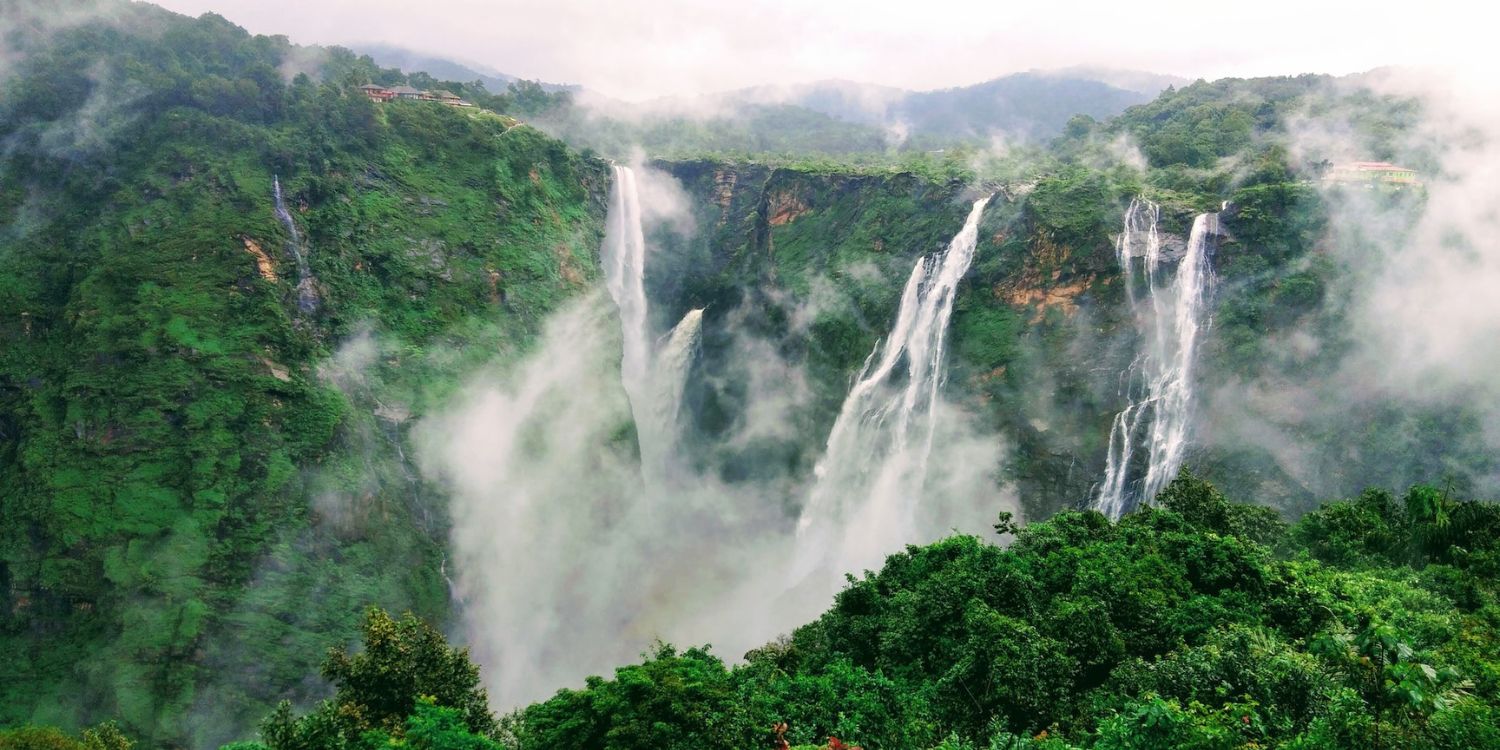South India, with its rich cultural tapestry and diverse geography, is home to numerous stunning waterfalls. These natural marvels are not only breathtaking in their beauty but also hold deep cultural and spiritual significance. For centuries, waterfalls in South India have been woven into the myths, legends, and religious practices of the region, representing symbols of divine power, prosperity, and purification. From sacred rivers cascading down hillsides to waterfalls that are believed to have divine origins, these natural wonders are integral to the local heritage. This blog will explore the cultural significance, mythological associations, and heritage of waterfalls in South India.
Introduction: The Natural and Cultural Landscape of South India
South India is known for its lush forests, rolling hills, and pristine rivers, which are complemented by the stunning beauty of its waterfalls. States like Karnataka, Tamil Nadu, Kerala, Andhra Pradesh, and Telangana boast an impressive array of waterfalls that are visited by tourists and revered by locals. These waterfalls, beyond their scenic appeal, have deep connections to the ancient traditions of the region.
Waterfalls in South India are often located near temples or places of pilgrimage, making them an integral part of religious journeys. These falls are celebrated in local folklore, ancient epics, and religious scriptures, reflecting their place in the collective consciousness of the people. The cultural significance of waterfalls in South India spans from their role in rituals and religious festivals to their representation in art and literature.
1. Waterfalls in Mythology: Divine Origins and Connections
Water is an important element in Indian mythology, representing life, fertility, and purity. Waterfalls, as powerful and majestic displays of water, have naturally become associated with divine figures in Hindu mythology. Many of South India’s most famous waterfalls are connected to legends of gods and goddesses, who are believed to have blessed or created them.
1.1. Jog Falls (Karnataka) – The Legend of Shiva
Jog Falls, located in the Shimoga district of Karnataka, is one of the highest waterfalls in India. This magnificent waterfall is associated with Lord Shiva, one of the principal deities in Hinduism. According to local legend, the four streams that combine to form the waterfall – Raja, Rani, Rocket, and Roarer – are manifestations of Shiva’s divine power. The locals believe that these streams represent the cosmic energy that Shiva releases when he performs the Tandava, a dance symbolizing the cycle of creation and destruction.
The region around Jog Falls is also steeped in spiritual significance. Pilgrims visit the falls to offer prayers and perform rituals, believing that the waters have healing properties. The natural beauty of the falls, combined with their connection to Shiva, makes Jog Falls a revered site in South Indian mythology.
1.2. Courtallam Falls (Tamil Nadu) – A Place of Spiritual Purification
Courtallam Falls, situated in Tamil Nadu, is known as the “Spa of South India” due to its medicinal properties. The water from the falls is said to flow over numerous medicinal herbs in the Western Ghats, making it beneficial for health. In Hindu mythology, Courtallam Falls is associated with Lord Shiva and is a popular pilgrimage site.
According to legend, Sage Agastya, one of the revered sages in Indian mythology, meditated near the Courtallam Falls. He is said to have prayed for the welfare of the southern region of India, leading to the formation of the waterfall. As such, the waters of Courtallam are believed to purify the soul and cleanse one of their sins. Every year, thousands of devotees visit Courtallam to bathe in the falls, believing that it brings spiritual purification.
2. Waterfalls and Temples: Religious Pilgrimage and Rituals
Waterfalls are often located near sacred temples or places of pilgrimage, making them an integral part of religious practices in South India. These waterfalls are considered manifestations of divine energy, and pilgrims visit them to seek blessings, perform rituals, and partake in religious festivals. The association between waterfalls and temples reflects the belief in the sacredness of nature in Hinduism.
2.1. Talakona Waterfalls (Andhra Pradesh) – The Abode of Lord Venkateswara
Talakona Waterfalls, located in the Sri Venkateswara National Park in Andhra Pradesh, is one of the tallest waterfalls in South India. This waterfall holds great spiritual significance, as it is believed to be the resting place of Lord Venkateswara, a form of Lord Vishnu. The name “Talakona” itself is derived from the Telugu words ‘tala’ (head) and ‘kona’ (hill), symbolizing that the waterfall is the head of the Seshachalam Hills, where Lord Venkateswara resides.
Devotees visit Talakona not only for its scenic beauty but also to seek blessings from the deity. The waterfall is located near a temple dedicated to Lord Venkateswara, where pilgrims offer prayers and perform rituals. The natural surroundings of the waterfall, combined with the religious significance of the area, make Talakona a popular destination for spiritual seekers.
2.2. Hogenakkal Falls (Tamil Nadu) – The Sacred Waters of the Kaveri River
Hogenakkal Falls, located on the Kaveri River in Tamil Nadu, is another example of a waterfall with deep religious significance. The Kaveri River itself is considered sacred in Hinduism, and the falls are seen as a manifestation of the river’s divine power. Pilgrims visit Hogenakkal to take a holy dip in the waters, believing that it will cleanse them of their sins.
The Kaveri River is personified as the goddess Kaveri in Hindu mythology, and it is believed that bathing in the river can bring blessings of fertility and prosperity. The area around Hogenakkal Falls is dotted with temples dedicated to various deities, making it a significant religious site in South India.
3. Waterfalls as Symbols of Prosperity and Fertility
In addition to their religious significance, waterfalls in South India are also seen as symbols of fertility and prosperity. Water is a life-giving force, and the abundance of water in waterfalls is often associated with agricultural prosperity and the fertility of the land. This is especially important in a region like South India, where agriculture has historically been the backbone of the economy.
3.1. Athirapally Falls (Kerala) – The Life-Giving Waters of the Chalakudy River
Athirapally Falls, located in the state of Kerala, is one of the most famous waterfalls in South India. The falls are situated on the Chalakudy River, which is an important source of water for agriculture in the region. The river and the falls are seen as symbols of fertility and prosperity, as they provide the necessary water for the cultivation of crops.
The surrounding forests and wildlife also thrive due to the presence of the waterfall, further reinforcing the idea of Athirapally as a life-giving force. Local communities have long revered the falls for their contribution to the region’s agricultural and ecological prosperity.
3.2. Iruppu Falls (Karnataka) – A Blessing for the Land
Iruppu Falls, located in the Kodagu district of Karnataka, is another waterfall that is associated with fertility and prosperity. According to Hindu mythology, the falls are believed to have been created by Lord Rama during his search for Sita. It is said that when Lord Rama was thirsty, he shot an arrow into the ground, and water gushed out, forming the Iruppu Falls.
The waters of the falls are considered sacred, and it is believed that they have the power to purify the soul and bring blessings of fertility to the land. During the festival of Shivaratri, devotees visit the nearby Rameshwara Temple and take a holy dip in the Iruppu Falls, hoping for divine blessings.
4. Waterfalls in Art, Literature, and Culture
Waterfalls have not only inspired religious devotion but have also been celebrated in South Indian art, literature, and culture. The natural beauty of waterfalls, combined with their cultural significance, has made them a popular subject in traditional art forms like painting, sculpture, and literature.
4.1. Waterfalls in Classical Literature
Classical Tamil and Kannada literature often reference waterfalls as symbols of beauty, power, and divinity. In Tamil Sangam poetry, rivers and waterfalls are frequently described as places of love and longing. Waterfalls are portrayed as majestic natural phenomena that evoke awe and reverence in the hearts of those who witness them.
In Kannada literature, waterfalls are often depicted as sacred sites where gods and goddesses reside. The works of poets like Kuvempu and D.R. Bendre celebrate the natural beauty of Karnataka’s waterfalls, while also acknowledging their cultural and religious importance.
4.2. Waterfalls in Traditional South Indian Art
Waterfalls are a recurring theme in traditional South Indian art, particularly in temple sculptures and paintings. Temples near waterfalls often feature carvings that depict deities associated with water, such as Ganga and Yamuna. These artistic representations serve to emphasize the sacredness of the waterfalls and their connection to the divine.
Waterfalls are also a popular subject in contemporary South Indian art, where they are often portrayed as symbols of natural beauty and environmental conservation.
Conclusion: Waterfalls as Cultural and Spiritual Symbols in South India
The waterfalls of South India are not just natural wonders; they are deeply intertwined with the cultural, religious, and spiritual traditions of the region. From their associations with gods and goddesses in Hindu mythology to their role in religious rituals and festivals, these waterfalls are revered as symbols of divine power, fertility, and prosperity.









